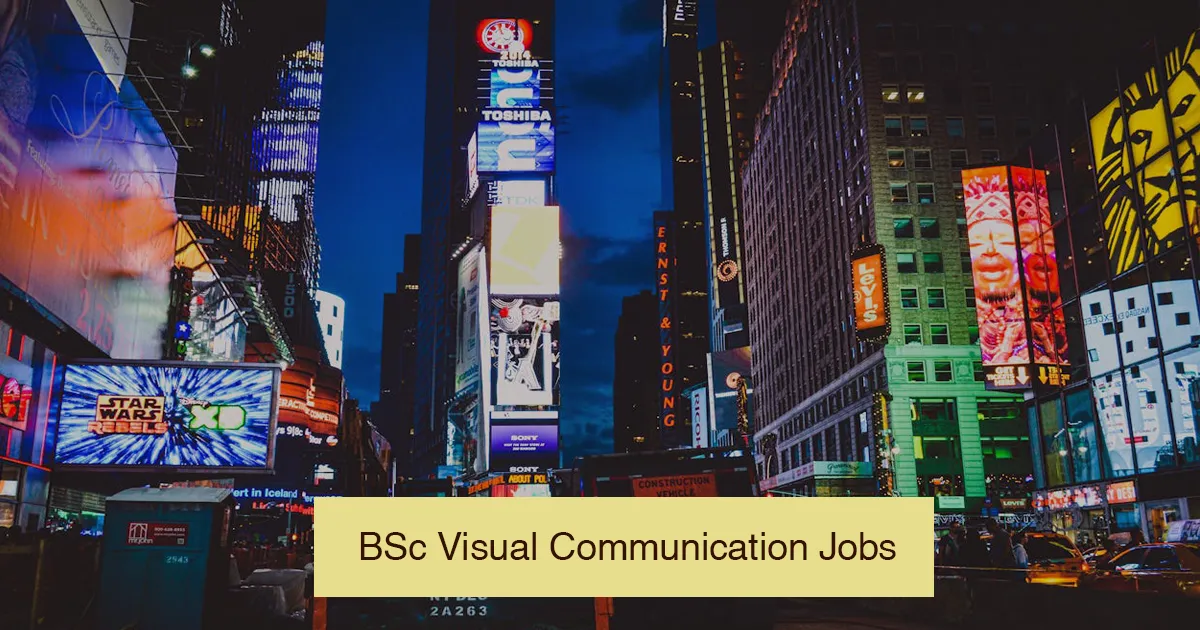Blog Detail


BSc Visual Communication Jobs: Scope, Salary and Career Opportunities
15-05-2025

The world of media, design, and storytelling is evolving, and with it grows the demand for professionals who can creatively communicate ideas through visuals. A Bachelor of Science (BSc) in visual communication opens the door to a space where creativity meets technology. The curriculum enables students to translate concepts into compelling content across digital and traditional platforms. The career opportunities span across design studios, advertising agencies, film production, social media management, and more.
This blog explores BSc visual communication jobs, industry demand, salary expectations, further study options and more, giving aspiring students and graduates a well-rounded understanding of what lies ahead.
Understanding the role of a visual communication graduate
Graduates from a visual communication programme are trained to design, create and communicate ideas using text, imagery, animation and video. These professionals are often at the core of media strategy, digital branding, UI/UX development and creative storytelling in print and broadcast media. The discipline brings together graphic design, multimedia art, animation, cinematography, photography and even aspects of marketing communication.
Exploring BSc viscom job opportunities
The versatility of the programme ensures abundant job opportunities for viscom students in both creative and technical roles. Many students begin with internships at advertising agencies, digital marketing firms, or media houses, eventually transitioning into full-time roles. Others explore BSc visual communication jobs such as freelance design, photography or content creation.
Additionally, industries like gaming, education technology and virtual reality are increasingly hiring visual communicators for immersive content development.There are diverse BSc visual communication jobs across these sectors.
The growing prominence of digital media has significantly increased the demand for visually skilled professionals. Graduates can pursue careers in various roles such as:
- Graphic Design – Creating logos, advertisements, layouts, and branding materials for both print and digital media..
- Motion Graphics & Animation – Creating animated videos for marketing, entertainment, or educational purposes.
- Photography & Cinematography – Taking on professional roles in photography, videography, and film direction for media houses, studios, or freelance projects.
- Web Design & UI/UX – Designing interfaces and experiences for websites and apps.
- Advertising & Brand Strategy – Assisting brands visually communicate their values and products through strategic campaigns.
- Broadcast Media – Working in television or digital content production as editors, producers or directors.
- Social Media & Content Creation – Developing visual content tailored for platforms like Instagram, YouTube and more.
The growing content-driven economy ensures that BSc viscom job opportunities are only expanding across creative industries.
BSc visual communication salary: what to expect
The BSc visual communication salary can vary widely based on role, location, experience and skill set.
Entry-level positions such as graphic designers or video editors typically offer salaries between ₹2.5 to ₹4.5 lakhs.
Specialised roles in UI/UX design or animation offer higher earnings. As professionals gain experience and build a strong portfolio, they can receive higher salaries and move into leadership positions like creative director. Freelancing opportunities also offers competitive pay, with growth opportunities based on innovation and portfolio strength.
Career after BSc visual communication: a long-term view
A career after BSc visual communication offers endless creative job opportunities. Many graduates progress into leadership positions like art director, creative director, or brand consultant. Others pursue careers in academia, research or set up independent studios.
The versatility of visual communication allows professionals to transition across industries, including education, healthcare, fashion, and technology.
PG courses after BSc visual communication
For those looking to enhance their expertise, several PG courses after BSc visual communication are available. These include:
- Master’s in Graphic Design
- Master’s in Animation or VFX
- MA in Media and Communication
- Master’s in UI/UX Design
- MFA (Master of Fine Arts)
- MBA in Media Management or Advertising
Postgraduate studies offer an opportunity to develop niche skills, gain industry exposure, and secure higher-paying roles.
BSc visual communication scope
The BSc visual communication scope is broader than ever due to the growth of digital media, advertising and content consumption. As companies race to create unique and engaging brand stories, the need for skilled visual communicators continues to rise.
In conclusion, a BSc in Visual Communication offers abundant career opportunities across diverse industries. From e-learning platforms to entertainment channels, and startups to multinational corporations, job opportunities abound for graduates. Whether you’re interested in graphic design, animation, UI/UX, or social media content creation, this degree provides the skills and versatility needed for a dynamic and rewarding career.
FAQs
Q1. What is the scope of BSc Visual Communication?
A1. The scope of BSc Visual Communication includes a wide range of creative careers in design, media, advertising, filmmaking, digital marketing, UI/UX, and animation. It prepares graduates to work in both traditional and emerging media platforms, with the flexibility to adapt to diverse industries globally.
Q2. What is the salary of BSc Visual Communication?
A2. The salary of BSc Visual Communication graduates typically ranges from ₹2.5 to ₹4.5 lakhs per annum at entry level, depending on the role and location. With experience, niche skills and a strong portfolio, professionals can earn significantly more, especially in high-demand areas like UI/UX and animation.